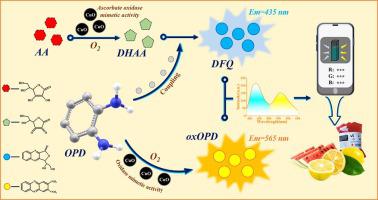Microchemical Journal ( IF 4.9 ) Pub Date : 2021-10-16 , DOI: 10.1016/j.microc.2021.106921 Ke Wang 1 , Jian Liu 2 , Xin Wang 1 , Xiaoyang Liu 1 , Jinshuang Hu 1 , Enshou Li 1 , Yusai Zhao 1 , Rusong Zhao 1, 3 , Shenghong Yang 1

|
Copper oxide nanoparticles (CuO NPs) as nanozymes have received extensive attention due to their numerous advantages such as water solubility and biomimetic effects. In this work, we combined the inherent oxidase and ascorbate oxidase mimetic activity of CuO NPs to construct a ratiometric fluorescence system for the detection of ascorbic acid (Vitamin C, AA) in serum and fruits. By feat of the dual mimic nanozymatic activity of CuO NPs, the sole substrate o-phenylenediamine (OPD) can be catalyzed to attain yellow fluorescent 2,3-diaminophenazine (oxOPD), while oxidized AA will react with the pristine OPD to form blue fluorescent product. This method has a sensitive response to AA with a good linear relationship in the concentration range of 1–150 μM and low detection limit of 0.16 μM. Practical sample detection of AA in human serum and fruits can be realized reasonably with the recovery rates between 84.83% and 87.28% and 88.53%-113.1%, respectively. More conveniently, the method can be successfully used for scanning measurement analysis through the associated application (ColorAssist) on smartphones and portable UV lamps.
中文翻译:

基于CuO纳米酶双驱动催化的比例荧光检测系统与经典单变量校准用于测定血清和水果中的抗坏血酸
氧化铜纳米颗粒(CuO NPs)作为纳米酶因其水溶性和仿生效应等众多优点而受到广泛关注。在这项工作中,我们结合了 CuO NPs 的固有氧化酶和抗坏血酸氧化酶模拟活性,构建了一个用于检测血清和水果中抗坏血酸(维生素 C、AA)的比率荧光系统。通过 CuO NPs 的双重模拟纳米酶活性,可以催化唯一底物邻苯二胺 (OPD) 获得黄色荧光 2,3-二氨基吩嗪 (oxOPD),而氧化的 AA 将与原始 OPD 反应形成蓝色荧光产品。该方法对 AA 响应灵敏,在 1-150 μM 的浓度范围内具有良好的线性关系,检测限低至 0.16 μM。可合理实现人血清和水果中AA的实际样品检测,回收率分别在84.83%、87.28%和88.53%-113.1%之间。更方便的是,该方法可以通过智能手机和便携式紫外线灯上的相关应用程序 (ColorAssist) 成功用于扫描测量分析。













































 京公网安备 11010802027423号
京公网安备 11010802027423号